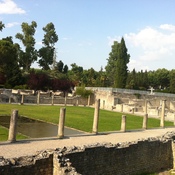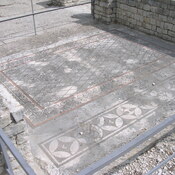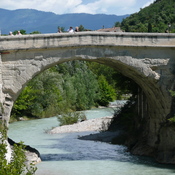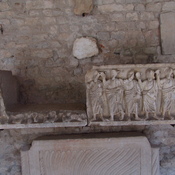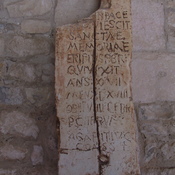The Roman theatre of Vaison was constructed on the northern face of the Puymin hill, within the archaeological site of the same name. It was built in the first century CE, possibly during the reign of the emperor Claudius, and could house about 6000 visitors. Internal galleries, as well as a staircase to the south, offered access to the seating area. A long tunnel dug southwards through the hill likely facilitated processions. At the theatre were discovered a marble copy of the Diadumenus by the Classical-period sculptor Polyclitus, now in the British Museum, as well as statues depicting Claudius, Hadrian, and his wife Sabina, which are exhibited at the nearby Musée archéologique Théo Desplans. The statues likely stood within the theatre's scaenae frons, of which the foundations still remain visible today.
Localisation:
- France, Vaison-la-Romaine
- geo:44.243896,5.075382
- Précision ± 0-5 m.
Period or year:
- 50~ / unknown
Classification:
- Théâtre
- Visible
Identificateurs:
- vici:place=10687
- pleiades:place=148228
- dare:place=20809
Annotations
The Roman theatre of Vaison was constructed on the northern face of the Puymin hill, within the archaeological site of the same name. It was built in the first century CE, possibly during the reign of the emperor Claudius, and could house about 6000 visitors. Internal galleries, as well as a staircase to the south, offered access to the seating area. A long tunnel dug southwards through the hill likely facilitated processions. At the theatre were discovered a marble copy of the Diadumenus by the Classical-period sculptor Polyclitus, now in the British Museum, as well as statues depicting Claudius, Hadrian, and his wife Sabina, which are exhibited at the nearby Musée archéologique Théo Desplans. The statues likely stood within the theatre's scaenae frons, of which the foundations still remain visible today.
À proximité
Vaison, "Maison à la tonnelle"
Vaison-la-Romaine, "Maison à la tonnelle"
Archäologische Museum Theo Desplans
Archäologische Museum Theo Desplans
Puymin Archäologische Stätte (Vaison-la-Romaine)
Puymin Archäologische Stätte (Vaison-la-Romaine)




